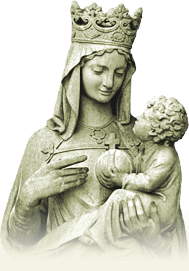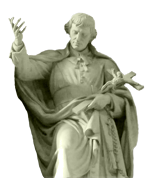Artigos
Igreja
Una Voce America entrevista Ken Jones, autor do Index of leading catholic indicators
Porque você decidiu criar seu Índice de Principais Indicadores Católicos?
Por dois motivos primárias. Primeiro, não existe nenhuma outra fonte simples e de fácil leitura que colete as estatísticas vitais da Igreja. Este livro. Este livro nasceu da frustração. Eu tenho ouvido referências vagas à "falta de padres", mas eu descobri que quando quis examinar a extensão desta carência ou as tendências de várias décadas, foi difícil conseguir boas referências. Além disso, as estatísticas sobre outras áreas da vida da Igreja além do sacerdócio – como as freiras, estudantes de colégios católicos, batismo e casamentos – foram ainda mais difíceis de conseguir. Eu gastei um bom tempo rastreando estes números, e decidi escrever o livro porque penso que outras pessoas possam ter o interesse em olhá-los também.
Meu segundo motivo para escrever o livro foi contribuir para a discussão atual sobre os efeitos do Concílio Vaticano II. Todos nós temos nossos próprios sentimentos e opiniões sobre a Igreja desde o Vaticano II. Alguns insistem que estamos experimentando uma renovação vibrante, outros dizem que estamos sofrendo uma era de desintegração sem precedentes. Eu sou um advogado – Eu quero evidencias, não sentimentos ou anedotas para suportar meu veredicto.
Qual é o seu veredicto?
Eu apenas posso concordar com o que o Cardeal Ratzinger disse: "Estamos nos defrontando com um progressivo processo de decadência... É incontroverso que este período é definitivamente desfavorável para a Igreja Católica". Desde que o Cardeal Ratzinger fez estes comentários em 1984, a crise na Igreja acelerou. Em cada área que é estatisticamente verificável – por exemplo, o número de padres, seminaristas, paróquias sem padres, freiras, freqüência às missas, conversões e anulações – o "processo de decadência" é inegável.
Você encontrou alguma estatística particularmente perturbadora?
A crise do sacerdócio é obviamente de maior preocupação para todos católicos, uma vez que a falta de padres diminui nosso acesso aos sacramentos. Uma pequena estatística que ilustra a crise é esta: existem mais padres nas idades entre 80 e 84 anos do que existem na idade entre 30 e 34. Olhando para isto do ponto de vista estritamente secular, não há muito futuro para qualquer organização que tem mais de seus funcionários de linha de frente com idade superior aos 80 anos que funcionários com idade na faixa dos 30 anos. Em 2020 teremos apenas 15000 padres com idade abaixo dos 70 anos.
A falta de padres tem criado um problema desconhecido para os católicos modernos – as paróquias sem padres. Paróquias sem padres eram virtualmente desconhecidas no tempo do Concílio, apenas 3 % delas, 549, estavam sem padres em 1965. Em 2002 eram 2.928 paróquias sem padres, cerca de 15% das paróquias americanas. Em 2020, um quarto de todas as paróquias; 4.656 não terão padres.
Como era de se esperar, a escassez de padres tem sido alimentada pelo colapso da população dos seminários. Havia 49.000 seminaristas em 1965. Em 2002 o numero despencou para 4.700 – uma queda de 90%. Sem estudantes, incontáveis seminários pelo país foram vendidos ou fechados. Haviam 596 seminários em 1965, e apenas 200 em 2002.
ANO
Nº de Seminaristas
1920
9000
1940
17000
1950
25000
1960
40000
1965
49000
1970
28000
2002
4700
A devastação das ordens religiosas de mulheres desde o Vaticano II pode apenas ser descrita como chocante. Em 1965 haviam quase 180.000 freiras nos Estados Unidos. Hoje existem 75.000, com uma idade média de 69 anos. Em 2020 nos projetamos que serão 21.000 abaixo dos 70 anos. Não seria alarmismo dizer que durante nossas vidas, não haverá virtualmente nenhuma freira nos Estados Unidos – uma reviravolta desconcertante nos eventos desde 1965.
As estatísticas mostram algo sobre a vida ordinária dos Católicos?
Novamente, em todas as áreas houve um declínio dramático. Em 1965 haviam 1.3 milhões de batismo de crianças, em 2002 houveram 1 milhão. (No mesmo período o número de católicos nos Estados Unidos cresceu de 45 para 65 milhões). Em 1965, houve 126.000 batismos de adultos – conversões – em 2002 houve 80.000. Em 1965, houve 365.000 casamentos católicos, em 2002 houve 256.000. Em 1968, houve 338 anulações, em 2002 houve 50.000.
O comparecimento às missas também caiu. Um pesquisa do Gallup de 1958 reportou que 74% dos Católicos iam à missa dominical. Um estudo da Universidade de Notre Dame descobriu que a freqüência caiu para 26,6%. Um estudo mais recente feito pelo professor James Lothian da Universidade Fordham concluiu que 65% dos católicos iam à missa aos domingos , enquanto a taxa caiu para 25% em 2000.


E a educação católica?
Esta é uma área que particularmente me surpreendeu, porque não estava a par de quão dramaticamente caíram as matrículas nas escolas católicas desde o Concílio. Por exemplo, entre 1965 e 2002, o numero de colégios diocesanos caiu de 1.566 para 786, e o número de estudantes caiu de quase 700.000 para 386.000. As escolas do nível primário, que eram 10.503 escolas paroquiais em 1965, passaram a 6.623 em 2002. O numero de seus estudantes caiu de 4,5 milhões para 1,9 milhões.
Algumas pessoas dizem: "Sabemos que o número caiu desde o Concílio, mas a tendência de queda começou antes do Concílio". Como responder? Eu respondo dizendo que isto simplesmente não é verdade. Uma característica especialmente auxiliadora para meu livro é que minha análise começa na década de 20 e 30, então as tendências podem ser descobertas. Por exemplo, olhe para o número total de seminaristas. Existiam cerca de 9.000 em 1920, 17.000 em 1940, 25.000 em 1950, quase 40.000 em 1960, e 49.000 em 1965 – uma tendência constante de crescimento. Em 1970 eram 28.000 seminaristas – um declínio superior a 41% em apenas cinco anos. Em 2002 eram apenas 4.700. Este padrão é refletido em cada área – Um crescimento vigoroso até o Concílio, e um declínio dramático logo a seguir.
Eis uma nova objeção: algumas pessoas dizem podem dizer que você está fazendo um argumento post hoc, ergo propter hoc – apenas por que algo aconteceu após o Concílio não significa que foi causado pelo Concílio. Você tem uma resposta para isto?
Eis minha resposta: Por várias décadas antes do Concílio, a Igreja na América estava em meio a um período de crescimento sem precedentes. Imediatamente após o Concílio, que foi convocado para renovação da Igreja – para fazer os números melhorarem mais ainda – fomos atingidos por um tremendo declínio em cada área. A correlação é patente demais para negar.
Por fim, penso, meu propósito em escrever o Index of Leading Catholic Indicators não é fazer argumentações – é simplesmente apresentar os fatos às pessoas para que elas possam tirar suas próprias conclusões.
UVA Interviews Ken Jones, Author of Index of Leading Catholic Indicators
Una Voce America director Fred Haehnel recently sat down with Ken Jones, vice president of Una Voce St. Charles, to discuss his new book, Index of Leading Catholic Indicators: The Church since Vatican II. Mr. Jones is an attorney and legal publisher in St. Louis. His translation from the French of Cardinal Hoyos’ letter to Bishop Bernard Fellay of the Society of St. Pius X was published in the August-September 2002 issue of Inside the Vatican.
Why did you decide to put together your Index of Leading Catholic Indicators? For two reasons primarily. First, there really isn’t any other single, easy-to-read source that collects the vital statistics of the Church. This book was born out of frustration. I had heard a lot of vague references to a "priest shortage," but I discovered that when I wanted to examine the extent of the shortage or the trends over several decades, it was difficult to get my hands on a good reference. Moreover, statistics about other areas of Church life besides the priesthood - such as nuns, Catholic school students, baptisms and marriages - were even more difficult to find. I spent a lot of time tracking down these numbers, and decided to write the book because I thought other people would be interested in looking at them too.
My second reason for writing the book was to contribute to the ongoing discussion about the effects of the Second Vatican Council. We all have our own gut feelings about the Church since Vatican II. Some insist we’re experiencing a vibrant renewal, others say we’re suffering through an era of unprecedented disintegration. I’m a lawyer - I want evidence, not feelings or anecdotes, to support my verdict.
What is your verdict? I can only agree with what Cardinal Ratzinger said: "We find ourselves faced with a progressive process of decadence. ... It is incontrovertible that this period has definitely been unfavorable for the Catholic Church." Since Cardinal Ratzinger made these remarks in 1984, the crisis in the Church has accelerated. In every area that is statistically verifiable – for example, the number of priests, seminarians, priestless parishes, nuns, Mass attendance, converts and annulments – the "process of decadence" is undeniable.
Do you find any of the statistics particularly striking? The crisis in the priesthood is obviously of supreme concern for all Catholics, since a lack of priests diminishes our access to the sacraments. One little statistic that encapsulates the crisis is this - there are more priests age 80 to 84 than there are age 30 to 34. Looking at it from a strictly secular point of view, there’s not much of a future for any organization that has more front-line workers in their 80's than in their 30's. The handwriting is on the wall. By 2020 there will be only about 15,000 priests below the age of 70.
The shortage of priests has created a problem unknown to modern Catholics – the priestless parish. Parishes without a resident priest were virtually unknown at the time of the Council; only 3 percent of them, 549, were without a priest in 1965. In 2002 there were 2,928 priestless parishes, about 15 percent of U.S. parishes. By 2020, a quarter of all parishes, 4,656, will have no priest.
As one would expect, the priest dearth has been fueled by a collapse in the seminarian population. There were 49,000 seminarians in 1965. By 2002 the number had plunged to 4,700 - a 90 percent decrease. Without any students, countless seminaries across the country have been sold or shuttered. There were 596 seminaries in 1965, and only 200 in 2002.
The devastation of religious orders of women since Vatican II can only be described as shocking. In 1965 there were almost 180,000 nuns in the United States. Today there are 75,000, with an average age of 69. By 2020 we have projected that there will be 21,000 below age 70. It is not being an alarmist to say that within our lifetime, there will be virtually no nuns in the United States - a stunning turn of events since 1965.
Do the statistics show anything about the ordinary life of Catholics? Again, in all areas there has been a dramatic decline. In 1965 there were 1.3 million infant baptisms, in 2002 there were 1 million. (In the same period the number of Catholics in the United States rose from 45 million to 65 million.) In 1965 there were 126,000 adult baptisms - converts - in 2002 there were 80,000. In 1965 there were 352,000 Catholic marriages, in 2002 there were 256,000. In 1968 there were 338 annulments, in 2002 there were 50,000.
Attendance at Mass has also plummeted. A 1958 Gallup poll reported that 74 percent of Catholics went to Sunday Mass in 1958. A 1994 University of Notre Dame study found that the attendance rate was 26.6 percent. A more recent study by Fordham University professor James Lothian concluded that 65 percent of Catholics went to Sunday Mass in 1965, while the rate dropped to 25 percent in 2000.
What about Catholic education? This is one area that particularly surprised me, because I was not aware of how dramatically enrollment has declined at Catholic schools since the Council. For example, between 1965 and 2002 the number of diocesan high schools fell from 1,566 to 786, and the number of students dropped from almost 700,000 to 386,000. At the grade school level, there were 10,503 parochial schools in 1965 and 6,623 in 2002. The number of students went from 4.5 million to 1.9 million.
Some people say, "We know the numbers have declined since the Council, but the downward trend started before the Council." How do you respond? I respond by saying it’s simply not true. An especially helpful feature to my book is that my statistical analysis starts in the 1920s and 1930s, so trends can be discovered. For example, look at the number of total seminarians. There were about 9,000 in 1920, 17,000 in 1940, 25,000 in 1950, almost 40,000 in 1960, and 49,000 in 1965 - a consistent trend upward. In 1970 there were 28,000 seminarians - a decline of over 41 percent in just five years. In 2002 there were 4,700. This pattern is reflected in every area - a steady increase until the Council, and a dramatic decline afterwards.
Here’s another objection. Some people might say that you’re making a post hoc, ergo propter hoc argument - just because something happened after the Council doesn’t mean it was caused by the Council. Do you have an answer to that? My response is this. For several decades before the Council, the Church in America was in the midst of an unprecedented period of growth. Immediately after the Council, which was called to renew the Church - to make the numbers even better, really - we were hit with a tremendous decline in every area. The correlation is just too striking to deny.
In the end, though, my purpose in writing the Index of Leading Catholic Indicators is not to make any argument at all - it’s simply to present the facts to people so they can come to their own conclusions.
Para citar este texto:
"Una Voce America entrevista Ken Jones, autor do Index of leading catholic indicators"
MONTFORT Associação Cultural
http://www.montfort.org.br/bra/veritas/igreja/ken_jones/
Online, 20/04/2025 às 17:42:19h








